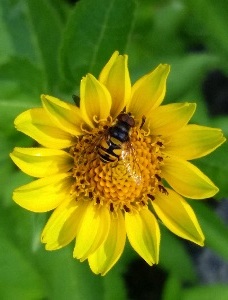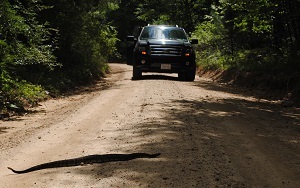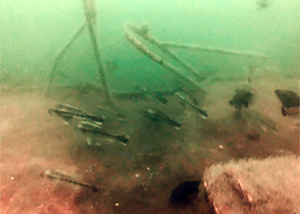Wildlife, Fish and Marine Life Newsletter
The New York State Department of Environmental Conservation sent this bulletin on 07/18/2018 05:32 PM EDT |
| DEC Delivers - Information to keep you connected and informed from the NYS Department of Environmental Conservation |
| Share or view as a web page || Update preferences or unsubscribe |
Wildlife, Fish, and Marine Life Newsletter |
Report Your Native Pollinator Sightings this Summer Through Early Fall
Our Participant Handbook (PDF, 2.5 MB) provides guidance for our citizen scientist volunteers. The handbook includes descriptions of the different ways to participate in the project and how to submit data from observations and surveys. Training workshops have finished up for this summer, but more will be available in the next two summers. Contact the New York Natural Heritage Program for more information. Photo by Sandy Van Vranken. Why did the Snake Cross the Road?
Smaller species such as common garter, smooth green, and red-bellied snakes may be difficult to spot on pavement. Larger species such as copperheads, black rat snakes, and rattlesnakes are easier to see and avoid hitting. Many will move out of the road when you approach, but some species will hold their ground. It is important to remember never to handle a venomous species; simply waiting for them to cross is an option. If in doubt, contact your county Environmental Conservation Officer for assistance. Photo by William Hoffman. Largest Artificial Reef Expansion in NYS History
Before material can be deployed at artificial reef sites, it must be inspected and cleaned of hazardous substances such as, petroleum products, asbestos, PCB's and more. DEC collaborates with multiple federal agencies to ensure material meets strict standards and is appropriate to use in marine environments. These materials will support the development of six artificial reefs on Long Island at sites off the shores of Smithtown, Shinnecock, Moriches, Fire Island, Hempstead, and Rockaway, increasing fisheries habitat and drawing in divers wanting to observe marine life. Download our brochure (PDF) describing the program with a map of all the reef sites. Watch DEC's artificial reef building video and learn about our volunteer observation program. |

 We are enlisting the help of volunteer citizen scientists who want to contribute to the
We are enlisting the help of volunteer citizen scientists who want to contribute to the  Snakes
Snakes Governor Cuomo announced
Governor Cuomo announced